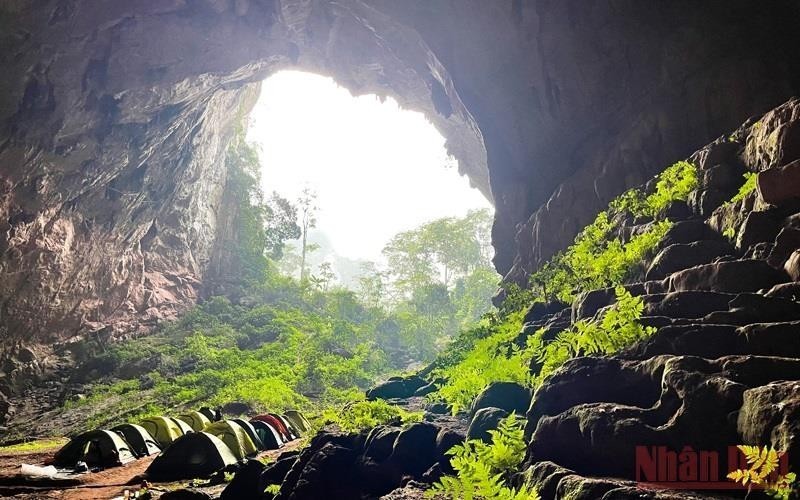
20 years of world heritage conservation of Phong Nha-Ke Bang National Park
Latest
 |
| On July 3, 2003, the UNESCO approved Vietnam's submission to recognise its Phong Nha-Ke Bang National Park as a World Natural Heritage Site. |
On July 3, 2003, the World Heritage Committee under the United Nations Educational Scientific and Cultural Organisation (UNESCO) approved Vietnam's submission to recognise its Phong Nha-Ke Bang National Park as a World Natural Heritage Site, with criteria of exceptional global value in terms of geology and geomorphology.
The recognition has been seen as a milestone that not only acknowledges the park’s outstanding values but also assesses efforts in preserving and promoting the heritage.
Twice honoured as World Natural Heritage
Covering 85,754 hectares, the park is located in the middle of the Annamite Mountain Range in Quang Binh province, and shares its boundary with the Hin Namno Nature Reserve in Laos to the west.
The property comprises an area of 123,326 ha and contains terrestrial and aquatic habitats, primary and secondary forest, sites of natural regeneration, tropical dense forests and savanna and is rich in large, often spectacular, and scientifically significant caves.
The park’s landscape is formed by limestone plateaus and tropical forests. It features great geological diversity and offers spectacular phenomena, including a large number of caves and underground rivers. The site harbours a high level of biodiversity and many endemic species. The extension ensures a more coherent ecosystem while providing additional protection to the catchment areas that are of vital importance for the integrity of limestone landscapes.
The Vietnamese Government, with the support of international organisations, saw the park expand to more than 123,000 hectares to preserve the largest ancient limestone region in Southeast Asia.
On July 3, 2015, at the 39th meeting in Bonn, Germany, the UNESCO’s World Heritage Committee agreed to add the criterion of outstanding value representing the evolutionary and development processes of terrestrial ecosystems, possessing meaningful natural habitats for biodiversity conservation.
The national park is a model of "Ecosystem and Biodiversity" with a unique population not found anywhere else on Earth, an evergreen tropical forest with a 500-year-old cypress species.
The recognition has become a significant milestone that not only acknowledges the global value of the site but also efforts in preserving and promoting the heritage resources values.
It also creates the basis for sustainable development of the heritage with value promotion and natural resources preservation in parallel.
Therefore, over the past 20 years, the park management board has taken conservation management as the foundation, scientific research as the core, and heritage value promotion as the driving force.
Sustainable heritage preservation
Over the past two decades, the board has consistently regarded forest management and protection as a primary mission.
Such applications as specific, measurable, achievable, relevant, and time-bound (SMART) and geographic information system (GIS) and drones have been optimised in forest patrol, biodiversity and soil monitoring, and the assessment of natural and human-induced impacts.
 |
| The park’s landscape is formed by limestone plateaus and tropical forests. It features great geological diversity and offers spectacular phenomena, including a large number of caves and underground rivers. |
Thanks to such efforts, the effectiveness of resources management has been improved significantly. Wildlife populations and sightings there have also increased, especially langurs.
More than 2,000 people from international conservation communities have so far visited the Phong Nha – Ke Bang National Park for research purposes. All of them have unanimously affirmed that this is an exceptionally rare natural heritage site on a global scale.
Research is the cornerstone in preserving the value of natural resources. Over the past 20 years, the management board has proactively collaborated with both domestic and international organisations to implement scientific projects and tasks in various fields, including the environment, geology-geomorphology, ecology, biodiversity, and culture - history.
The park has announced a catalogue of nearly 3,000 species of flora, with five newly discovered; and nearly 1,400 species of fauna, with 38 newly found; and produced over 91,000 forestry seedlings from 124 species.
Notably, the 500-year-old limestone coniferous forest has been found in the Phong Nha-Ke Bang National Park, with a total area of about 4,000 hectares.
Furthermore, the park has received and rescued nearly 1,500 wild animals, and released 1,335 animals back into the wild. It is now home to 64 rescued wild animals of various species, including seven Indochinese tigers.
Since 2003, experts from the Royal British Cave Association surveyed and discovered 425 caves in seven areas and systems, of which 389 caves have been measured with a total length of 243 km. The most prominent was the discovery of Son Doong - the world's largest cave. The site is important in caving research in the region, promoting the image of Vietnam and Quang Binh and Phong Nha-Ke Bang around the world.
Apart from managing and preserving the heritage, the management board has also paid special attention to promoting its values through tourism and service activities.
Currently, the World Natural Heritage site has 15 different routes possible on a tour that include various combinations of nature exploration, caves, camping, walking, and zip line areas.
Notably, the tour to explore Son Doong cave is regarded as one of the international-level tourism tours.













